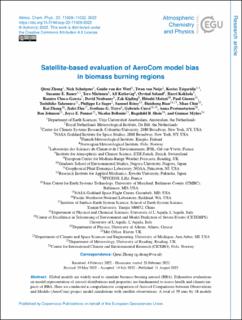| dc.description.abstract | Global models are widely used to simulate biomass burning aerosol (BBA). Exhaustive evaluations on model representation of aerosol distributions and properties are fundamental to assess health and climate impacts of BBA. Here we conducted a comprehensive comparison of Aerosol Comparisons between Observations and Models (AeroCom) project model simulations with satellite observations. A total of 59 runs by 18 models from three AeroCom Phase-III experiments (i.e., biomass burning emissions, CTRL16, and CTRL19) and 14 satellite products of aerosols were used in the study. Aerosol optical depth (AOD) at 550 nm was investigated during the fire season over three key fire regions reflecting different fire dynamics (i.e., deforestation-dominated Amazon, Southern Hemisphere Africa where savannas are the key source of emissions, and boreal forest burning in boreal North America). The 14 satellite products were first evaluated against AErosol RObotic NETwork (AERONET) observations, with large uncertainties found. But these uncertainties had small impacts on the model evaluation that was dominated by modeling bias. Through a comparison with Polarization and Directionality of the Earth’s Reflectances measurements with the Generalized Retrieval of Aerosol and Surface Properties algorithm (POLDER-GRASP), we found that the modeled AOD values were biased by −93 % to 152 %, with most models showing significant underestimations even for the state-of-the-art aerosol modeling techniques (i.e., CTRL19). By scaling up BBA emissions, the negative biases in modeled AOD were significantly mitigated, although it yielded only negligible improvements in the correlation between models and observations, and the spatial and temporal variations in AOD biases did not change much. For models in CTRL16 and CTRL19, the large diversity in modeled AOD was in almost equal measures caused by diversity in emissions, lifetime, and the mass extinction coefficient (MEC). We found that in the AeroCom ensemble, BBA lifetime correlated significantly with particle deposition (as expected) and in turn correlated strongly with precipitation. Additional analysis based on Cloud-Aerosol LIdar with Orthogonal Polarization (CALIOP) aerosol profiles suggested that the altitude of the aerosol layer in the current models was generally too low, which also contributed to the bias in modeled lifetime. Modeled MECs exhibited significant correlations with the Ångström exponent (AE, an indicator of particle size). Comparisons with the POLDER-GRASP-observed AE suggested that the models tended to overestimate the AE (underestimated particle size), indicating a possible underestimation of MECs in models. The hygroscopic growth in most models generally agreed with observations and might not explain the overall underestimation of modeled AOD. Our results imply that current global models contain biases in important aerosol processes for BBA (e.g., emissions, removal, and optical properties) that remain to be addressed in future research. | en_US |

